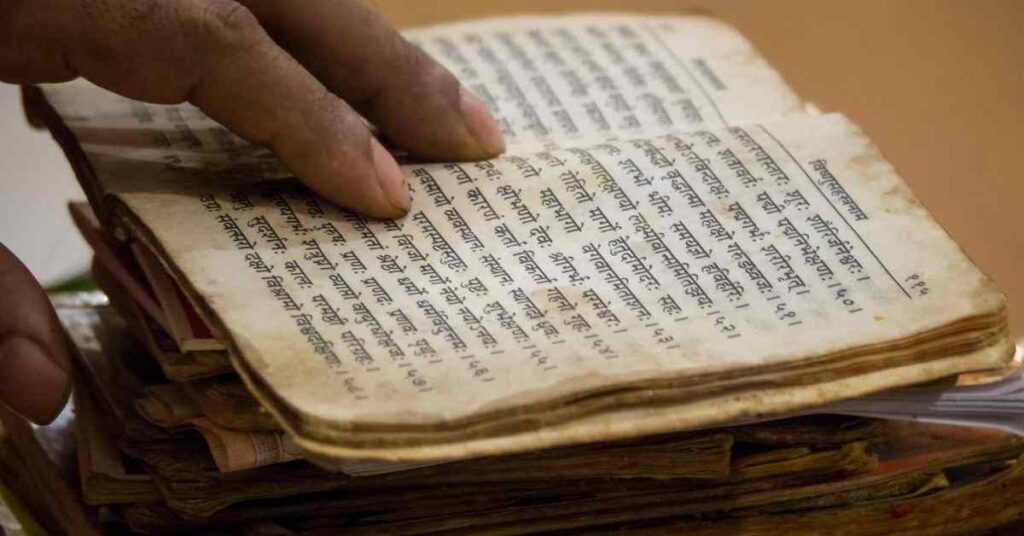Hinduism is a vast religion with a strong emphasis on traditional values and teachings. One of its most important core beliefs is the scriptures, also known as shastras.
But do you know how many shastras there are? Each one offers guidance on topics such as the proper conduct of life, philosophy, and spiritual growth; but understanding them can be difficult for those new to Hinduism.
In this blog post, I will provide an overview of the various types and numbers of shastras present in Hindu scripture. Additionally, I will discuss what each type covers and why they continue to remain so relevant even today.

Introductions to the Different Shastras
The Shastras, which are ancient Hindu texts, encompass a vast range of topics and knowledge. There are 18 main Shastras, each covering a different area of expertise such as astrology, music, medicine, and politics.
These texts have been passed down through generations and continue to hold great significance in Hindu culture. Studying the Shastras can provide a deeper understanding of not only Hinduism but also of the intricacies of life.
Whether you are seeking to broaden your knowledge, delve into a new area of interest, or simply have great admiration for Hindu texts, an introduction to the different Shastras is a valuable journey to embark upon.
History and Background of Shastras
The Shastras are a collection of ancient texts that provide guidance and wisdom for those seeking to live a spiritual and meaningful life.
Originating in India thousands of years ago, these texts cover a wide range of topics, including philosophy, religion, science, literature, and more. From the Vedas and Upanishads to the Puranas and Epics, the Shastras have had a profound influence on Indian culture and continue to be studied and revered today.
Through their timeless teachings, the Shastras offer a unique window into a fascinating and complex time in human history, providing insights into the beliefs, values, and practices of ancient civilizations.
The Six Major Shastras
The Six Major Shastras are an integral part of Hindu philosophy and religious tradition. These ancient texts, written in Sanskrit, are considered the authoritative source of knowledge on various aspects of life, such as astronomy, rituals, politics, grammar, medicine, and art.
Their teachings have shaped the way of life for Hindus for centuries and continue to offer insight into the complex nature of the universe and human existence. Despite their age, the Shastras remain relevant even today, as they provide a solid foundation for spiritual and personal growth.
Their importance cannot be overstated, making them a must-read for anyone interested in Hinduism or Eastern philosophy.
Vedic Shastras & Upanishads
The Vedic Shastras and Upanishads are ancient texts that have contributed greatly to Indian philosophy and spiritual understanding. The Vedic Shastras consists of four collections of sacred texts that were passed down orally for centuries before finally being written down.
These texts contain a plethora of information on ritualistic practices, sacrifice, and divinity. The Upanishads, on the other hand, are philosophical treatises that explore the nature of reality, the self, and the ultimate goal of life.
They are considered by many to be the core of Hindu philosophy and have influenced the development of other spiritual traditions as well. Overall, the Vedic Shastras and Upanishads remain relevant today and continue to shape the beliefs and practices of millions of people around the world.
Dharma Shastra – Laws of Hinduism
The Dharma Shastra, also known as the Laws of Hinduism, is a set of guidelines that govern every aspect of a person’s life. This ancient text lays out rules and regulations for individuals to lead a good and ethical life.
The guidelines in the Dharma Shastra are precise and clear and cover topics such as personal conduct, familial duty, and social obligations. It serves as a roadmap to guide Hindus towards righteous living, emphasizing the importance of justice, mercy, and kindness towards all beings.
The Dharma Shastra has been an essential part of Hinduism for thousands of years, and its influence can be seen in many aspects of modern Indian culture.
Smriti Texts – Social Customs & Traditions
Delving into Smriti’s texts reveals a treasure trove of social customs and traditions. From the sacred institution of marriage to the various rites of passage, such as birth and death, these texts provide a comprehensive insight into the customs and traditions of the Indian subcontinent.
The Smritis also offers detailed guidance on social etiquette, ethical behavior, and individual responsibilities in society. Their relevance, even today, is undeniable as they continue to shape the social fabric of South Asian societies.
Overall, the Smritis encapsulates the beauty and diversity of the region’s social customs and traditions, making them an invaluable resource for anyone seeking to understand the region’s culture and history. Find the necessary steps to follow Hinduism.
Nyaya & Vaisheshika – Logic & Scientific Knowledge
Nyaya and Vaisheshika are two ancient Indian philosophical schools that were instrumental in shaping the development of logic and scientific knowledge in the country.
Nyaya focused on the rules of reasoning and argumentation, while Vaisheshika concerned itself with ontology and metaphysics. Together, these two schools offer a comprehensive understanding of the ways in which logic and scientific knowledge were conceived and developed in ancient India.
Their intellectual contributions continue to influence scholars and enthusiasts today, and their legacy remains an important part of the country’s intellectual and cultural heritage.
Mimamsa – Rituals & Devotion
Mimamsa is a school of Hindu philosophy that studies the nature of rituals and devotion. Through rigorous examination of Vedic scriptures, Mimamsa scholars aim to understand the significance and purpose of various rituals and practices performed in Hinduism.
Devotion is seen as a key aspect of these rituals, as it is believed to foster a deeper connection with the divine. Mimamsa emphasizes the importance of understanding and performing rituals correctly, in order to achieve the desired spiritual benefits.
Through its focus on ritual and devotion, Mimamsa offers insights into the rich and complex religious traditions of India. This is one of the reasons why Ganesh was worshipped first in Hinduism.
Vedanta – Ultimate Reality & Enlightenment
Vedanta is a profound philosophical system from India that explores the nature of ultimate reality and the means to attain enlightenment. In the Vedantic worldview, there is one ultimate reality, which is known as Brahman.
This reality is infinite, eternal, and unchanging, and it underlies all of existence. The mystical experience of realizing Brahman is called enlightenment, and it is the ultimate aim of spiritual practice in Vedanta.
To attain enlightenment, one must cultivate self-awareness, quiet the mind, and develop a deep understanding of the nature of reality. Ultimately, Vedanta offers a path of self-discovery, transformation, and liberation that leads to lasting peace, happiness, and fulfillment.
Conclusion on the Shastras and their Significance in Modern Times
The Shastras, a collection of religious texts from ancient India, are still highly regarded in modern times for their significance in moral and ethical behavior. Despite being written thousands of years ago, the lessons contained within them still resonate with people today.
The Shastras provide guidance on how to live a fulfilled and meaningful life, emphasizing the importance of self-discipline and compassion towards others. Their teachings have been used to inspire individuals and communities alike, shaping the way they approach the world around them.
In our fast-paced and ever-changing society, the principles found in the Shastras remain relevant and important to consider in one’s personal and professional life.
By considering the various Shastras and their history, we can gain a powerful understanding of Hinduism.
The six major Shastras have allowed us to explore religious practices, social customs and traditions, logic and scientific knowledge, rituals, devotion, ultimate reality, and enlightenment. In modern times, it is important that we understand the Shastras’ regards to our human behavior in order for us to move forward as a collective. Why not begin by taking a look into one or two of the six major Shastras today?
For those who are seeking deeper insights into the rich heritage of Hinduism, there is much value to be found in this ancient body of literature.
By engaging with these timeless texts, we can gain a further understanding of ourselves and how to live our lives. Ultimately, Hinduism reveals that though each human life is a cycle of creation, preservation, and dissolution; we can find peace within our inner being through understanding the true power of compassion and joy.
Find more about Shastras here.


